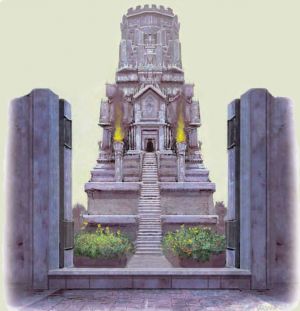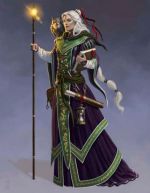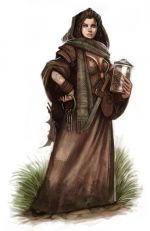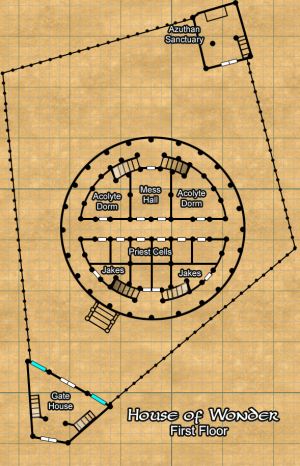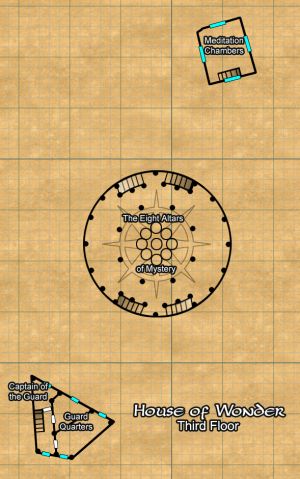Difference between revisions of "House of Wonder"
| Line 27: | Line 27: | ||
Rather than taking the temple away from the Watchful Order, Sendra suggested to the Order that they help sponsor the school and allow it to remain on the temple grounds. Indeed, the temple has started taking on students other than those with Watchful Order connections, sometimes even doing so for free when a particularly promising student cannot afford the fees of the school. Its students frequently become members of the Watchful Order, and some even remain as clergy. | Rather than taking the temple away from the Watchful Order, Sendra suggested to the Order that they help sponsor the school and allow it to remain on the temple grounds. Indeed, the temple has started taking on students other than those with Watchful Order connections, sometimes even doing so for free when a particularly promising student cannot afford the fees of the school. Its students frequently become members of the Watchful Order, and some even remain as clergy. | ||
| + | ===Sanctified Site=== | ||
| + | The House of Wonder qualifies as a Mystran sanctified site, allowing her ordained clergy (Rank 3+) to cast spells with the maximum possible damage or other trait that is normally randomized by a dice roll. | ||
==Temple Titles & Perks== | ==Temple Titles & Perks== | ||
There are three Factions at work within the House of Wonder: the Temple Hierarchy, the Academy Hierarchy, and that of the Knights of the Mystic Fire. | There are three Factions at work within the House of Wonder: the Temple Hierarchy, the Academy Hierarchy, and that of the Knights of the Mystic Fire. | ||
Revision as of 17:06, 24 January 2019
House of Wonder
|
Temple of Mystra
|
North Diamond Street, Sea Ward, Waterdeep
|
Founded 1215 DR
|
Personages
|
• Population: 65 total
33 clergy (8 mages, 3 clerics, 5 bards, 17 priests; 25 ordained priests, 8 acolytes) 12 academy apprentices 20 temple guard (6 Knights of the Mystic Fire, 14 guards) • High Priest: Temple Magister Sendra Arunsun • Master of Acolytes: Candos Restlar • Academy Headmaster: Marwenna Wands • Captain of the Guard: Thalai Ogolakanu • Noble Patrons: House Wands |
Services
|
| Apprenticeship (wizard), curse removal, healing, ritual, social |
Faction Details
|
| Common Descriptors: Arcane, spiritual, servant of the Mysteries Primary Classes: Wizard (primary), cleric, paladin, sorcerer, bard, fighter (eldritch knight), rogue (arcane trickster) Alignments: LN, N, NE |
Faction Ranks
|
| • Servant of Mystery: Rank 1. You are a sworn servant of Mystra, and ordained as novice clergy within the temple. You aid higher ranking priests in the sacred rites of the temple, and perform some basic services for lay worshippers in need of one-on-one aid. • Lord/Lady of Mystery: Rank 3. You are a fully ordained priest of the temple's order, with the right to perform all the rites and services of the temple, save those reserved for the high priest or priestess. |
Waterdeep has a strong tradition of magery. Waterdhavians inclined to worhsip one of the "arcane" faiths have traditionally favored the Lady of Mysteries dating back to the establishment of the House of Wonder in the Year of Starlight (1215 DR).
In Waterdeep, the Church of Mystra has long played a secondary role to the Watchful Order of Magists & Protectors because the sale of spells and magic items is traditionally in the province of the guild, not the church. Waterdeep's Mystran church is closely allied with the Church of Selune, and the two faiths work together to battle the followers of Shar.
With the death of Mystra and destruction of the Weave, the House of Wonder suffered incredible damage, and in the height of the Spellplague was quarantined from the rest of the city, as the ravening arcane energies twisted and warped anyone who entered its demesnes. Once that faded, the House of Wonders stood empty, for without Mystra, there was no priesthood. The Watchful Order eventually took over the compound, moving their school for wizardry into its ancient halls.
Then, with the Sundering, things changed. A tenday after every magician in Faerûn received the knowledge of Mystra's rebirth and the reconstruction of the Weave, two strangers came to the gates of the city: a man who identified himself only as the Magister of Mystra, and a silver-haired woman who bore a surname so familiar to Waterdhavians: Arunsun. Sendra rapidly began to reform the priesthood of Mystra, using old texts and new revelations from the Lady of Mystery, and over the course of the next year, the Magister returned several times, each time in the company of a newly Called cleric of Mystra.
In the intervening three years, the temple has restored the worship of the Lady of Mysteries rapidly. There are a few young clerics on hand, learning her lore and (for those with the inclination) pursuing ordination to the Mystran faith. Several of them have struck out on their own during that time as well. The first of the new clerics, Candos Restlar, remains as the Master of Acolytes.
Rather than taking the temple away from the Watchful Order, Sendra suggested to the Order that they help sponsor the school and allow it to remain on the temple grounds. Indeed, the temple has started taking on students other than those with Watchful Order connections, sometimes even doing so for free when a particularly promising student cannot afford the fees of the school. Its students frequently become members of the Watchful Order, and some even remain as clergy.
Sanctified Site
The House of Wonder qualifies as a Mystran sanctified site, allowing her ordained clergy (Rank 3+) to cast spells with the maximum possible damage or other trait that is normally randomized by a dice roll.
Temple Titles & Perks
There are three Factions at work within the House of Wonder: the Temple Hierarchy, the Academy Hierarchy, and that of the Knights of the Mystic Fire.
Temple Hierarchy
This Faction ranking system applies to those who are ordained in Mystra's service. (Note that references to Mystra below apply to Azuth as well, and the Azuthan titles are noted in parentheses.)
- Servant of Mystery: Rank 1+. You are an acolyte in the House of Wonder. You are entitled to a cot in the acolytes bunks, and to the simple meals served to acolytes and priests at the House of Wonder at no Lifestyle cost to you.
- Weavesight: Rank 2+ While you are on grounds sacred or sanctified to Mystra, you are treated as though you knew or had prepared detect magic. Additionally, you may cast this spell as a ritual, even if you don't normally have the ability to cast rituals.
- Dweomerkeeper: Rank 3+. You are now a fully ordained priest/ess of Mystra. While in an area sacred or sanctified to Mystra, you are treated as if you know or have prepared the ceremony spell. If you are of a spellcasting class that does not have ceremony, add that spell to your spell list. You retain this ability as long as you remain of at least rank 3 in this faction. You are entitled to space in one of the rectory buildings near the House of Wonder, where full priests dwell. You gain the effects of having a Modest Lifestyle without spending any coin.
- Temple Library & Laboratories: Rank 3+. You gain full access to the temple's library and laboratories. They are of quite high quality, although you are not guaranteed privacy while you work. You may not grant others access to these resources, however.
- Temple Spellcaster: Rank 3+. If you are a spellcaster, you can often find ample clients interested in hiring you to use your magic to their benefit. If you take the Spellcasting for Hire Downtime action, double the results of your check.
- Rites of Fire: Rank 5+. At this rank, you are invested with Mystran power to add the rites of Starflight and Magefire to your casting of the ceremony spell.
- Starflight: When casting the Coming of Age, Dedication, or Marriage functions of the ceremony spell, or as part of the initiation of an Acolyte to a Dweomerkeeper, the target of that spell is invested with the ability to fly while under the open sky with stars visible. The participants in the ceremony must expend a total of three levels worth of spell slots; until the sun rises or the target enters a covered area, they gain a fly speed of 30. This flight is accompanied by a sense of ecstatic wonder, which the faithful believe is the touch of the goddess.
- Magefire: This is an additional function of the ceremony spell. The rite of Magefire requires at least two ordained clergy of Mystra, one of whom must have the ability to expend spell slots, and spends at least one 1st level spell slot in the casting. The rite invests raw magical power, which manifests as silvery-blue flame that courses over the body of the spell's target. The target may immediately spend hit dice to heal, with each die healing its full amount. If there a higher level spell slot is spent in the casting (or multiple of them, from multiple priests), they may be spent to invest the target with a lesser restoration (2 spell slots), dispel magic (3 spell slots), or remove curse (3 spell slots), or greater restoration (5 spell slots). If at least 3 total spell slots are spent on the Magefire rite, it ends with the Starfight effect (assuming the proper conditions exist).
- Shrine Keeper: Rank 7+. As an elder priest, you have been invested with the authority and responsibility of overseeing one of the nine shrines of the House of Wonder: the eight Shrines of the Eightfold Star (one for each of the schools of magic), or the Shrine to Azuth. Through an hour of prayer at the shrine, you may add a wizard spell of up to the highest level you can cast to your known or prepared spells. This must be of the school that you are invested with responsibility for; the Azuthan shrine can grant any wizard spell, but can only grant spells of a level lower than you can cast. You also have Comfortable rectory quarters.
- Master of Acolytes: Rank 7+. As an experienced elder priest, you have been invested with the responsibility for training the next generation of priests. You have a small group of acolytes whom you teach who are also willing and able to assist you. Only one in five of these are spellcasters. You also have Comfortable rectory quarters.
- Temple Magister: Rank 10 • Bard, Cleric, Sorcerer, or Wizard only. You are the high priest/ess of the Temple of Wonder, and the ultimate authority and responsibility for its prospering. In addition to mustering all of the resources of the temple, you have the Temple Magister's Blessing, granted by Mystra (even if you are one of Azuth's ordained). Choose three spells, one of the highest level you can cast, and the other two of lower levels. While on the grounds of any space sacred and sanctified to Mystra, you are treated as if you knew those spells (if a bard or sorcerer) or as if you had those spells prepared (if a cleric or wizard). You may change these spells, but doing so takes a tenday in which you lose access to that specific spell entirely (though you retain access to the other two during that time). You also have Comfortable rectory quarters.
Temple Personages
| Sendra Arunsun Temple Magister • Rank 10 The head of the House of Wonder bears a notable surname, for she is the grand-daughter of Khrelan Arunsun, the fourth Blackstaff, and son of the original. Sendra is reclusive, and dedicated to Mystra's service. She is a powerful wizardess in her own right, though she does not "meddle" the way those in her lineage are known to have done (although many Waterdhavians simply assume her meddling is more subtle). As Temple Magister, she leads the rites of the House of Wonder, and does what she can to foster the worship of the Lady of Mysteries to those who seek it out. | |
| Candos Restlar Master of Acolytes • Rank 7 The priest responsible for the education of the temple's novices and acolytes, Candos is the highest ranking full cleric of Mystra in the temple. He takes his responsibility – both as a temple authority and as one of the Called of the Lady of Mysteries – quite seriously, though this sometimes takes the form of taking himself too seriously. He is very aware of his own dignities and pride, and a quick way to get on his bad side is to not respect both of those. That said, he is a very caring tutor and well-liked by his many students. | |
| Marwenna Wands Academy Headmistress • Rank 8 A noblewoman of the Wands line, Marwenna is whipcrack intelligent, to a degree that tends to intimidate those around her. Fortunately, she is also very skilled at creating harmony, even with normally cantankerous wizardly sorts (she likes to joke that her best spells were learned in comportment school). Marwenna oversees the teaching of the wizard apprentices, and is dear friends with both Sendra and with Bowgentra Summertaen, the Lady Master of the Watchful Order. |
Knights of the Mystic Fire
| Thalai Ogolakanu Knight-Captain • Rank 8 The massive Sir Thalai is the head of the Knights of the Mystic Fire in the House of Wonder, and makes quite a sight. He stands just shy of eight feet in height and wears gleaming plate, a trophy won from a champion of the Church of Cyric. Though quiet, he radiates a palpable sense of strength and protectiveness, and is very serious about protecting the Temple of Wonder and its students and priests. |
Services
| Spell | Cost |
|---|---|
| cure wounds (1st level) | 10 gp |
| cure wounds (2nd level) | 20 gp |
| lesser restoration | 40 gp |
| prayer of healing | 40 gp |
| cure wounds (3rd level) | 45 gp |
| dispel magic | 90 gp |
| remove curse | 90 gp |
| speak with dead | 90 gp |
| cure wounds (4th level) | 100 gp |
| divination | 210 gp |
| greater restoration | 450 gp |
| raise dead | 1000 gp |
- Apprenticeship: The House of Wonder and Watchful Order cooperate to teach those with promise the arts of wizardry, fostering in them Mystran morality and the Order's operational ethics as a basic part of their training. Its mentors come primarily from the Watchful Order, and its headmaster is both a priestess of the temple and a master in the Order. Most of the apprentices do not live at the temple, although those who need such accommodations are permitted space with the acolytes.
- Ritual: The House of Wonder offers a variety of rituals for the adherents of Mystran and Azuthan faiths. Many of the standard rites of faith – birth celebrations, weddings, funerals – are performed, all with a distinctly magical flavor. But the House also offers rites for events unique to wizards and other magicians: celebrations of being accepted as an apprentice, offerings of thanks for mastering a new circle of magic, rites of passage from apprentice to journeyman to master levels of proficiency, rites of sacrifice for luck in creating a new spell or magic item, anointing of new familiars, and so on.
- Social: The House of Wonder is always open to practitioners of the Art, with the express intention of building community among those who wield arcane power. Part of the temple's goal is to foster cooperative relationships among wizards and other magi, in the hopes that it will reduce the competitive and antagonistic relationships that often lead to spell-battle. A simple social is always held after every temple ritual, and the temple also frequently sponsors "wizards' balls," social events with music, dancing, and ample amounts of delightful magic to enhance the atmosphere.
- Spells: The House of Wonder will cast the spells indicated in the sidebar.
Layout
Grounds
The grounds of the House of Wonder are surrounded by a fine gate of wrought iron, each spoke in the gate topped with the Eightfold Star of Mystra at the crosspoint. The grounds themselves are wrought of fine white marble cobblestones, with blue-white cobbles forming the mosaic of the Eightfold Star from which rises the temple.
Three buildings are situated on the grounds: the Gatehouse, a defensive structure maintained by the Knights of Mystic Fire, Mystra's order of paladins; the Shrine to Azuth, tucked away at the rear of the compound; and the House of Wonder itself, a great circular tower.
Gatehouse
Headquarters for the local chapter of the Knights of Mystic Fire, the Gatehouse defends the sole entrance to the House of Wonder.
- Gate House: First Floor. The gatehouse serves as the point of entry for the House of Wonder. A Mystran acolyte is always on duty here, ready to welcome those who come to the House, offering to help them with whatever their needs may be. Beyond the entry vestibule, a pair of Knights of the Mystic Fire await, prepared to defend the House and sound an alarm rousing their companions to the temples' defense.
- Guard Room: Second Floor. There are always at least two guards on duty in the guard room, prepared to rush downstairs to the aid of their fellows and alert those paladins in the chambers above them. They are also the guards for the armory.
- Armory: Second Floor. With armor stands supporting finely-wrought suits of chain and plate in the center of the room, and walls with many shields (all showing the sign of Mystra) and weapons, the armory is the responsibility of the Knights. Several of these items are magical, but properties of the room muffle any magical auras - only the Knights and upper clergy of the temple know which ones are enchanted.
- Guard Quarters: Third Floor. The Knights of the Mystic Fire take five-day rotations of service in the House of Wonder. While all of them have quarters elsewhere in the city, when on duty, they dwell in one of the bunks in these quarters.
- Captain of the Guard's Quarters:' Third Floor. The captain of the temple guard, Dhaelos Marganathyr, dwells here full time.
Shrine to Azuth
Like most temples to Mystra, the House of Wonder includes a small shrine to Azuth. The Waterdhavian shrine is home to a handful of Azuthan clergy, more than half of them mages, who tend to the needs of the faithful and stand out among the Mystran clergy by dint of their gray robes among the Mystran blue.
- Sanctuary: First Floor. Here the faithful of Azuth and Mystra can frequently be found in contemplation and prayer. An altar burning with many candles in glass votives, each etched or scribed with a symbol that is a form of prayer, stands to one end of the sanctuary. Eight or so feet above the altar is a small shelf on which stands a statue of Azuth. Beside the door, a set of stairs rises to the gallery above. At least one Azuthan priest can be found here at all times.
- Ikon of Azuth: Second Floor. Above the altar in the sanctuary is a statue of Azuth, long-bearded and hooded, holding a staff in one hand, and his other raised in benediction, forming the gesture that is his holy symbol, his hand alight with mystical flame.
- Gallery: Second Floor. The gallery above the sanctuary is where the faithful are often taken to speak with clergy alone, or where the clergy remain during the rites to Azuth (which the faithful gather below), so that all eyes are upon the ikon of Azuth rather than his priesthood.
- Meditation Chambers: Third Floor. The faithful are always permitted space here. Though it may be used for general meditation and contemplation, it also finds extensive use by Azuthan faithful, who offer instruction in the Art or demonstration of their own breakthroughs as part of their service to the faith.
First Floor
Set into the temple's foundation, this floor - which is wider than the others - serves as living space. Beneath it is a wide-open set of cellars, used for storage and occasionally for the teaching of the temple's acolytes.
- Acolyte Dorms: Large open dormitories filled with bunks for the acolytes of the temple.
- Mess Hall: Eating space provided to the temple's clergy and guardians. Food is prepared off-premises and brought here to be served.
- Priest Cells: Though most of the temple clergy have dwelling places either in the nearby temple-owned row houses or simply in private dwellings elsewhere in the city, a handful of them maintain cells here. For the most part, these are either senior clergy or those responsible for teaching and overseeing the acolytes.
Second Floor
This is the main entry of the temple, a vast pillared circular chamber. In the center is a circular altar from which rises a flickering blue-white flame. Those who approach the altar find the flames parting, and the image of a serene, slightly aloof goddess - a depiction of Mystra - gazing at them from out of the flame, no matter which direction they approach the altar from.
Small side alcoves either provide access to the stairs up or down (and are usually watched over by an acolyte), or harbor small sitting areas with priests ready and able to discuss the needs of the faithful. The southermost alcove also holds a holy water font, where the faithful may purchase Mystran holy water from.
Third Floor
The Shrines of the Eightfold Star
Fourth Floor
Library & Labs
Fifth Floor
Ritual Chambers
